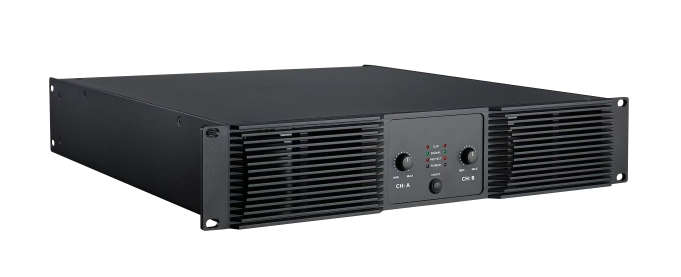Understanding Modern PA Amplification Systems
The world of professional audio has witnessed a remarkable evolution in PA amplifiers over the decades. From the warm, characteristic sound of traditional analog systems to the precision and versatility of modern digital solutions, PA amplifiers remain at the heart of any sound reinforcement setup. For audio professionals and enthusiasts alike, understanding the fundamental differences between analog and digital PA amplifiers is crucial for making informed decisions about sound system design and implementation.
Both analog and digital PA amplifiers serve the essential purpose of boosting audio signals to drive speakers, but they achieve this goal through distinctly different approaches. These differences impact everything from sound quality and reliability to functionality and integration capabilities. As we delve deeper into this topic, we'll explore how each type of amplifier operates and their respective advantages in various applications.
Core Technology and Signal Processing
Analog PA Amplifier Operation
Analog PA amplifiers operate by directly manipulating the electrical signal through various components like transistors, resistors, and capacitors. This traditional approach to amplification involves taking the input signal and increasing its voltage and current while maintaining the original waveform's shape. The process is continuous and occurs in real-time, without converting the signal to digital information.
The simplicity of analog signal paths often results in a characteristic warmth and naturalness that many audio professionals prize. Analog PA amplifiers typically feature straightforward controls like gain, EQ, and volume, making them intuitive to operate. However, this simplicity also means they have limited processing capabilities compared to their digital counterparts.
Digital PA Amplifier Technology
Digital PA amplifiers incorporate analog-to-digital converters (ADC) that sample the incoming audio signal and convert it into binary data. This digital information can then be processed using sophisticated algorithms before being converted back to an analog signal through a digital-to-analog converter (DAC). The entire process happens at incredibly high speeds, making it virtually imperceptible to the human ear.
The digital architecture allows for advanced features like precise filtering, limiters, delay compensation, and various audio enhancement tools. Modern digital PA amplifiers often include built-in DSP (Digital Signal Processing) capabilities, enabling complex signal manipulation that would be impossible with purely analog circuits.
Performance Characteristics and Sound Quality
Analog Sound Signature
Analog PA amplifiers are often praised for their musical character and natural harmonic richness. The continuous nature of analog signal processing can contribute to a more organic sound that some listeners find more pleasing, particularly for live music applications. When pushed to their limits, analog amplifiers tend to exhibit a gradual and musical type of distortion that can be aesthetically pleasing in certain contexts.
The frequency response of quality analog PA amplifiers is typically very flat across the audible spectrum, though component tolerances and temperature variations can affect performance over time. While this might require occasional maintenance and calibration, many users appreciate the predictable behavior and reliable performance of well-designed analog systems.
Digital Audio Excellence
Digital PA amplifiers excel in maintaining absolute accuracy and consistency in signal reproduction. Their precision comes from the ability to process audio with mathematical exactness, ensuring that the output remains faithful to the input signal regardless of environmental conditions. Digital systems can also implement sophisticated protection mechanisms without compromising audio quality.
Modern digital PA amplifiers often feature remarkably low noise floors and excellent dynamic range capabilities. The integration of advanced DSP allows for precise control over frequency response, phase alignment, and timing - critical factors in large-scale sound reinforcement applications. These capabilities make digital amplifiers particularly well-suited for complex installations where precise control and consistency are paramount.
Integration and System Design
Analog System Architecture
Traditional analog PA amplifiers typically require external processing equipment for advanced sound shaping and system protection. This means additional rack space, power requirements, and potential signal degradation through multiple connection points. However, the modular nature of analog systems can be advantageous, allowing for easy component replacement and system expansion.
Analog setups often involve more complex wiring schemes and careful consideration of signal flow to maintain optimal performance. While this might seem disadvantageous, it provides a level of transparency and direct control that many sound engineers appreciate, especially in troubleshooting scenarios.
Digital Network Integration
Digital PA amplifiers shine in their ability to integrate seamlessly with modern audio networks and control systems. Many current models feature ethernet connectivity, allowing for remote monitoring and control through dedicated software platforms. This network integration enables sophisticated system management, including real-time performance monitoring, preset recall, and automated fault detection.
The ability to store and recall complex configurations makes digital amplifiers particularly valuable in venues with multiple use cases or touring applications. Advanced features like load monitoring and impedance sensing help protect both the amplifier and connected speakers, while networking capabilities allow for centralized control of large distributed systems.
Practical Applications and Considerations
Venue-Specific Solutions
The choice between analog and digital PA amplifiers often depends on the specific requirements of the venue or application. Smaller venues with straightforward audio needs might benefit from the simplicity and reliability of analog amplifiers. These systems are often more cost-effective and require less technical expertise to operate effectively.
Larger venues and complex installations typically favor digital PA amplifiers for their advanced processing capabilities and network integration features. The ability to precisely tune and control multiple zones from a central location makes digital systems particularly valuable in challenging acoustic environments or installations requiring sophisticated audio distribution.
Future-Proofing Investments
When considering long-term investments in PA amplification systems, the expandability and upgradeability of digital platforms offer significant advantages. Digital amplifiers can often receive firmware updates that add new features or improve performance, while analog systems remain largely fixed in their capabilities.
However, analog amplifiers have proven their longevity and reliability over decades of use. Quality analog components, when properly maintained, can provide excellent performance for many years without the potential obsolescence concerns that might affect digital systems as technology advances.
Frequently Asked Questions
How do analog and digital PA amplifiers differ in terms of maintenance requirements?
Analog PA amplifiers typically require regular physical maintenance, including cleaning of potentiometers and checking component conditions. Digital amplifiers generally need less physical maintenance but may require occasional firmware updates and software management. Both types benefit from routine inspection and testing to ensure optimal performance.
Can analog and digital PA amplifiers be used together in the same system?
Yes, analog and digital PA amplifiers can be integrated into the same system with proper planning and interface consideration. Many professional installations use a hybrid approach, leveraging the strengths of both technologies. However, careful attention must be paid to signal flow and system design to maintain optimal performance.
What impact does latency have on digital PA amplifier performance?
While digital PA amplifiers introduce some latency due to signal processing, modern systems typically maintain extremely low latency levels that are imperceptible in most applications. High-end digital amplifiers often feature sophisticated algorithms to minimize latency while maintaining advanced processing capabilities.
How do environmental factors affect analog versus digital PA amplifiers?
Analog PA amplifiers are generally more susceptible to temperature variations and electromagnetic interference, which can affect their performance. Digital amplifiers tend to be more stable across varying environmental conditions, though extreme temperatures can still impact their operation. Both types should be properly ventilated and protected from adverse conditions for optimal performance.

